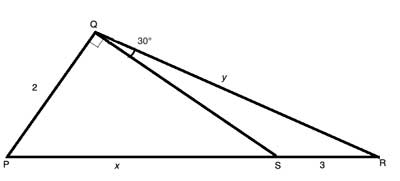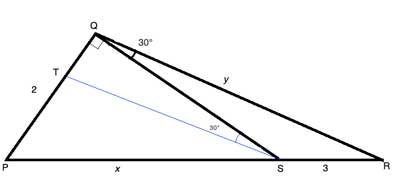One of my regular readers sent me the following problem, asking for my help in solving it. This is a challenging problem that was fun to solve, because it uses several concepts we have discussed earlier - similar triangles, 30-60-90 right triangles and the Pythagorean theorem - all in one problem!
It is also an opportunity to discuss how I approach such problems - what are the hints given in the problem that help me formulate the strategy to solve it. I encourage you to send me similar problems!
Problem
In the following drawing (not drawn to scale!), ∠PQS=90° and∠RQS=30°. The length of segment SR is 3, and segment PQ is 2. If the length of segment PS is x, and the length of segment QR is y, what is x ·y?

Strategy
Almost every time a problem asks us to find the product of two segments, it is a hint that we should use similar triangles. That is because we know that in similar triangles ΔABC∼ ΔDEF, the following relationship holds for a product of the sides: AB·EF = BC·DE.
Here we are asked to find such a product, of (x ·y), so we should look for similar triangles in which x and y are sides. Since it does not appear like the existing triangles are similar (one has a right angle, the other does not), we will likely have to construct such triangles. A common way to construct similar triangles from existing ones is to draw a line that is parallel to one of their sides. We will look for opportunities to do this here.
The second hint given in the problem is that ∠PQS=90°, so ΔPQS is a right triangle, with two known sides (PQ=2; PS=x), so we can find its third side (QS) using the Pythagorean theorem.
And the final hint is that we have an angle (∠RQS) which is 30°. This brings to mind the special triangle 30-60-90, where the relationships between the sides are easy to compute when only one side is known.
So, putting these three hints together, the strategy is that we will try to construct similar triangles in which y and x are sides, by drawing a line parallel to one of the sides, and hopefully make use of that 30° angle somewhere.
Solution
A little experimenting should give us the idea to draw a line ST, parallel to QR:

We now have two similar triangles, ΔQPR and ΔTPS.
ΔPQS is a right triangle, with 2 known sides (leg PQ=2; the hypotenuse, PS=x), so we can find its third side (QS) using the Pythagorean theorem: The length of SQ is √(x2-4).
Since we constructed ST ||QR, ∠RQS ≅∠QST, as alternating interior angles between parallel lines and m∠QST=30°. This means that ΔQTS is a 30-60-90 right triangle, where the long leg SQ is √(x2-4). So the short leg, QT= √[(x2-4)/3] and the hypotenuse ST is 2√[(x2-4) /3]
For simplicity, to avoid having to write out that long radical every time, let's set QT= √[(x^2-4) /3] =z, and so ST=2 ·√[(x2-4) /3] =2z
Now since the triangles ΔQPR and ΔTPS are similar,
PT/PQ=PS/PR so (2-z)/2=x/(x+3).
Cross multiplying , we get (2-z)(x+3) =2x, and simplifying we get 6=(x+3)z.
Looking again at the similar triangles, PR/QR=PS/ST so (x+3)/y=x/2z.
Cross multiplying again, 2(x+3)z= x·y, and from above, 6=(x+3)z, so x·y =2·6 = 12
